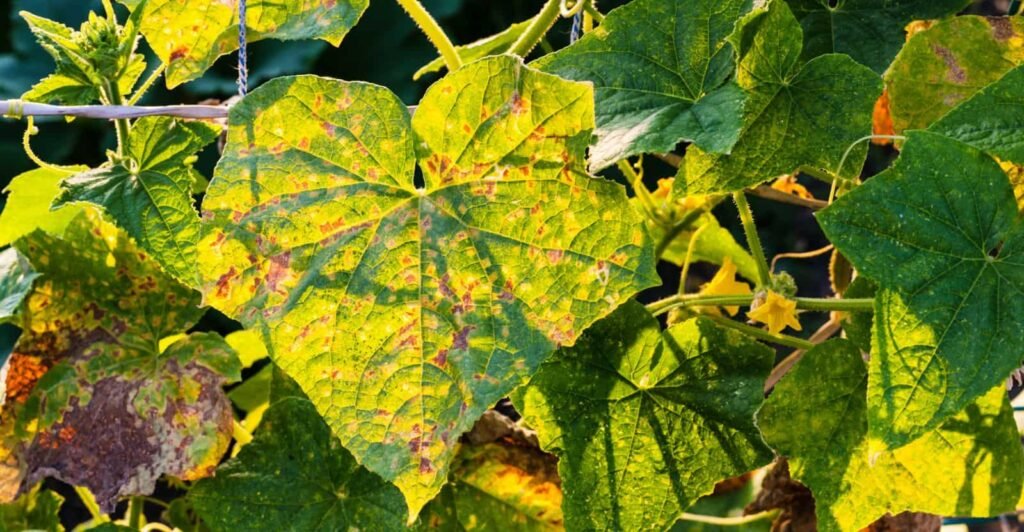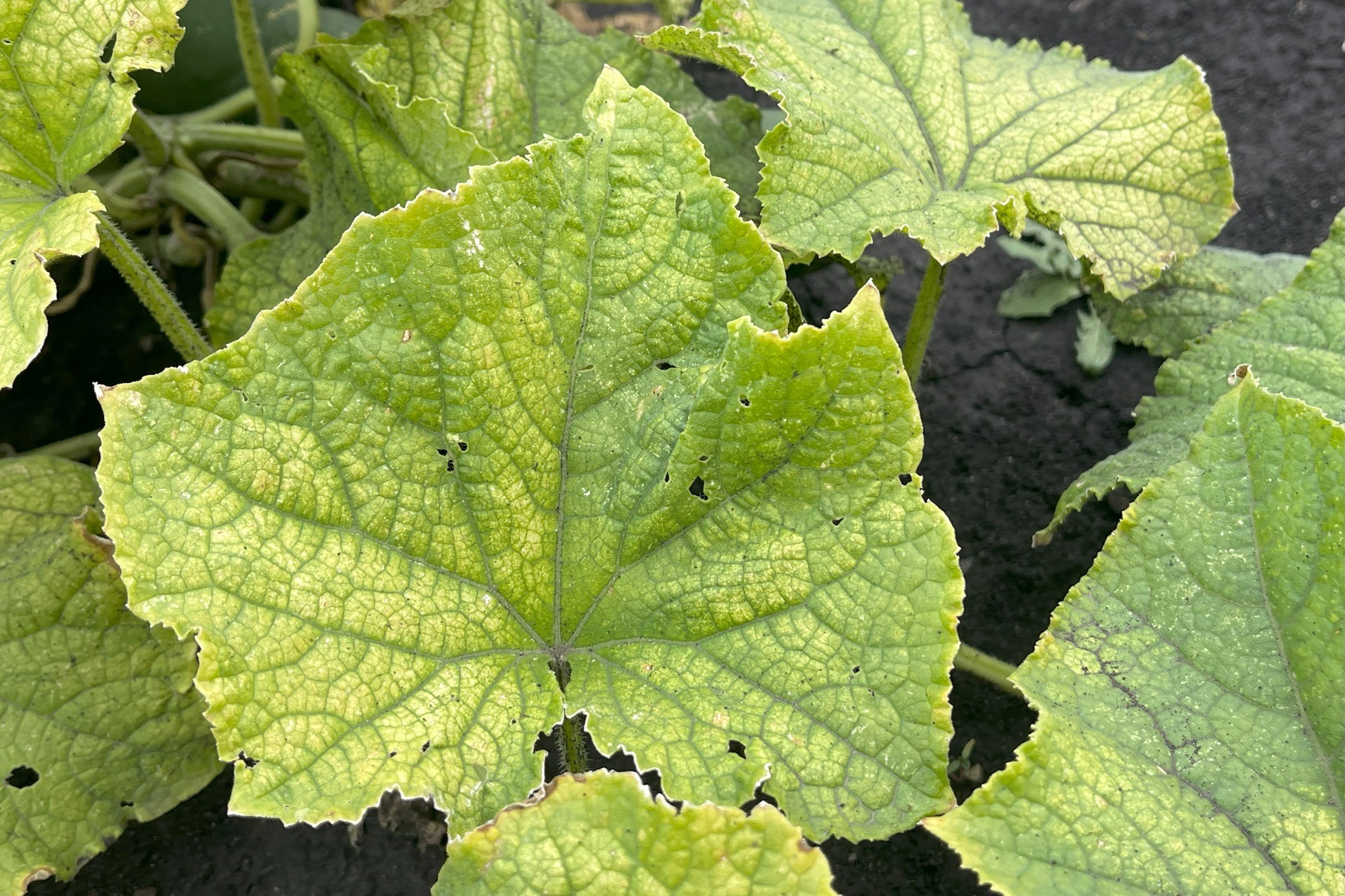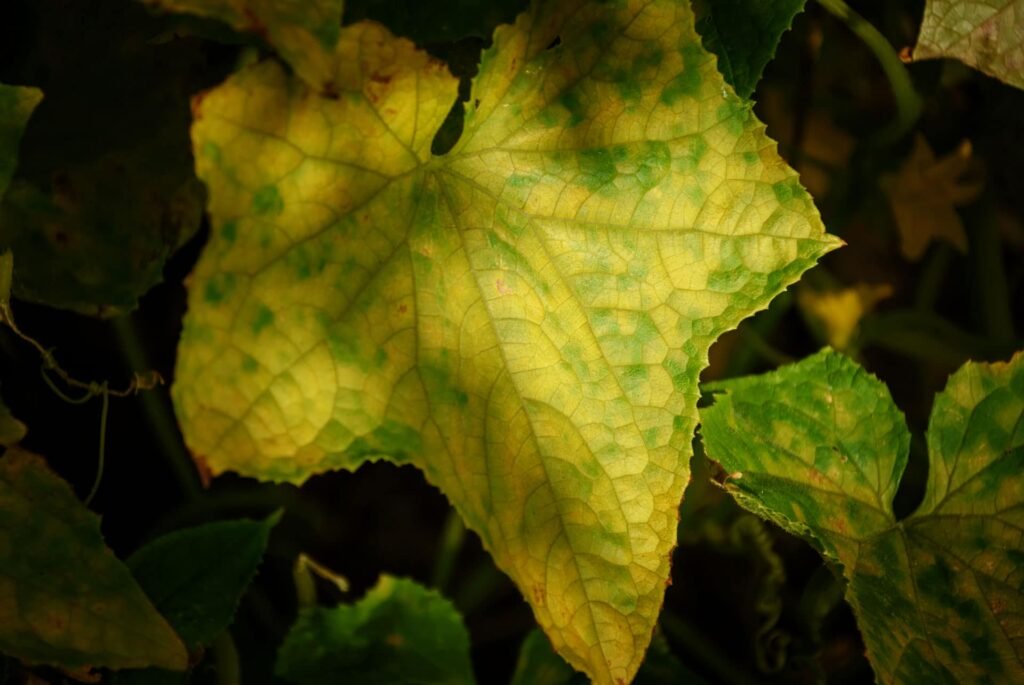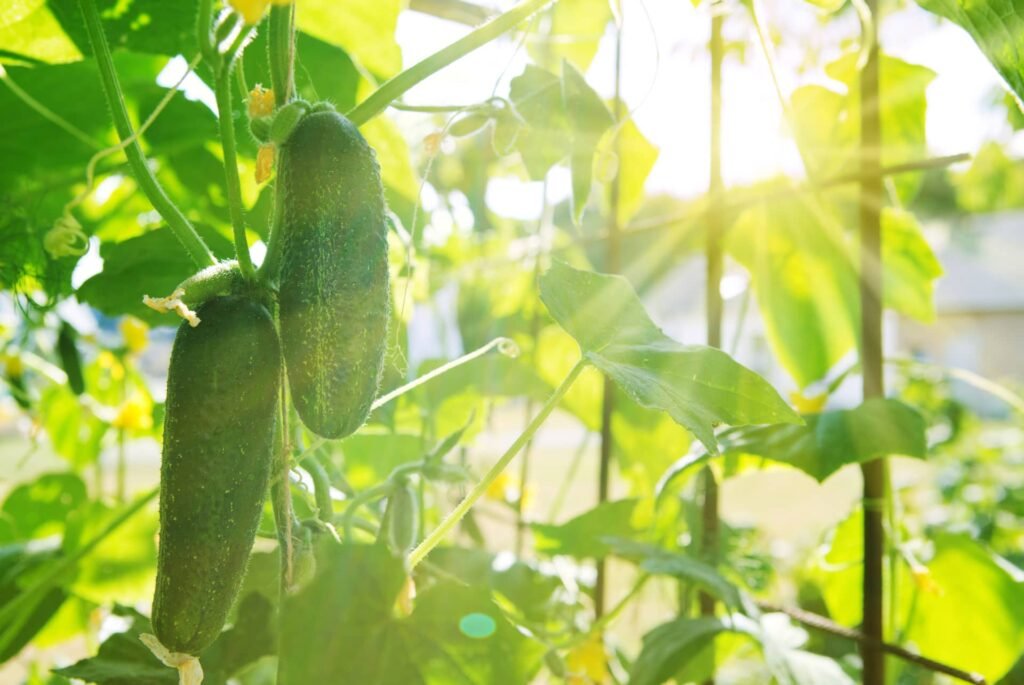
Why Are My Cucumber Leaves Turning Yellow?
If you’ve noticed that your cucumber leaves are turning yellow, don’t panic—it’s a common issue, and usually, the solution is simple once you figure out the cause. Cucumbers thrive in warm, sunny environments, and growing them in containers or raised beds in areas with plenty of light is often the best setup. But sometimes, things go wrong, and the plant starts showing signs of stress, like yellowing leaves.
Let’s break down some of the most common reasons behind yellowing cucumber leaves and what you can do to fix it.
Why Do Cucumber Leaves Turn Yellow?

The main culprit behind yellow leaves on cucumbers is usually chlorosis, which happens when the plant can’t produce enough chlorophyll. Chlorophyll is what gives the leaves their green color and helps the plant turn sunlight into energy. When the cucumber plant undergoes stress, it struggles to produce chlorophyll, and the result is yellowing leaves. Sometimes, you may also notice light brown streaks or curled leaves.
Here are the most common causes for cucumber leaves turning yellow:
1. Pest Attacks

Cucumbers are prone to a variety of pests that can damage their soft, juicy leaves, leading to stress and yellowing.
- Cucumber Beetles: These pests attack the roots, leaves, and flowers. They also spread bacterial wilt, which can make the plant wilt and become discolored.
- Aphids: These small insects feed on the nutrients in cucumber leaves, causing them to curl and yellow. Aphid infestations can spread quickly, so be sure to treat them early.
- Spider Mites: Tiny, reddish-brown insects that live on the undersides of cucumber leaves, causing yellow spots and general leaf damage. Shake the plant to see if you notice a cloud of these pests.
- Potato Leafhoppers: These insects feed on cucumber leaves, causing them to become stippled (with small dots), and they may even cause curling of the leaves. These pests also release a toxin that can make the plant’s growth stunted.
To deal with these pests, you can try natural solutions like neem oil or insecticidal soap. If you see signs of infection, removing affected leaves or using pesticides may be necessary.
2. Cucumber Plant Diseases

Cucumbers are susceptible to bacterial and fungal diseases, which can cause the leaves to turn yellow.
- Powdery Mildew: This fungal disease often appears in summer and weakens the plant, causing yellowing leaves. Proper watering and good air circulation can help prevent it.
- Cucumber Mosaic Virus: This serious disease causes yellow, mottled leaves and can kill the plant. There’s no cure, so if you see signs of it, remove the affected plant immediately to stop it from spreading.
To prevent diseases, plant disease-resistant cucumber varieties and ensure proper care.
3. Nutrient Deficiency

Cucumbers are heavy feeders, so they need a balanced supply of nutrients. A lack of essential nutrients can lead to yellowing leaves.
- Nitrogen Deficiency: If the plant is lacking nitrogen, the leaves will start to turn yellow, especially the older leaves.
- Magnesium Deficiency: Without enough magnesium, cucumbers can develop yellow leaves, particularly between the veins. Adding Epsom salt can help, as it’s high in magnesium sulfate.
- Iron or Zinc Deficiency: Yellowing leaves, with green veins intact, can be a sign of iron deficiency, while zinc deficiency can cause yellowing on younger leaves.
To fix nutritional deficiencies, apply a balanced fertilizer, such as a slow-release or water-soluble type, and amend the soil with compost or organic matter to improve soil health.
4. Improper Watering

Cucumbers need consistent watering, but they don’t like sitting in waterlogged soil. Both overwatering and underwatering can stress the plant and cause yellow leaves.
- Overwatering: If you water too much, the roots can suffocate and rot, leading to yellowing leaves and overall plant stress.
- Underwatering: On the other hand, not watering enough can cause the leaves to dry out and turn yellow, especially in the hotter months.
Make sure to water cucumbers deeply, about 1 to 2 inches per week, and ensure the soil is well-drained. If you’re growing cucumbers in containers, make sure the container has drainage holes, and avoid letting the plant sit in water.
5. Cold Weather

Cucumbers are sensitive to cold weather. They thrive in temperatures above 50°F (10°C), and anything colder can cause yellowing leaves, wilting, and overall plant stress.
If the temperature drops below freezing or if there’s frost, bring your cucumber plants indoors, or cover them with a frost cloth to protect them.
6. Lack of Sunlight

Cucumbers need at least 6 to 8 hours of sunlight per day to grow properly. If they’re placed in a spot where they don’t get enough light, the leaves can turn yellow as the plant struggles to make food.
Make sure to plant your cucumbers in a sunny spot or move your container to a location with more light. If you’re growing cucumbers indoors and they’re not getting enough natural light, you may need to use a grow light.
Can Yellow Leaves Turn Green Again?

Once the leaves turn yellow, it’s tough to bring them back to their original green color. If the yellowing is due to nutrient deficiency, water issues, or lack of sunlight, you can correct these problems, and the plant may start growing new, healthy leaves. However, if the yellowing is due to pest damage, disease, or irreversible stress, it’s best to remove the affected leaves to prevent further damage to the plant.
How to Fix Yellow Leaves on Cucumbers

To fix yellowing leaves, start by identifying the root cause. Check for pests, disease, or improper care, and adjust as needed.
- Treat pests: Use natural remedies like neem oil or insecticidal soap to deal with pest infestations.
- Fix watering issues: Water consistently, ensuring the plant is neither too dry nor too wet.
- Improve soil health: Add compost or organic matter to improve soil nutrients, or apply a balanced fertilizer.
- Ensure enough sunlight: Move the plant to a sunnier spot if it’s not getting enough light.
By addressing the cause of yellowing, you can help your cucumber plant get back on track and continue to thrive.
Is Miracle-Gro Suitable for Cucumbers?

Yes! Miracle-Gro is a great option for cucumbers, as it provides the nutrients they need for strong growth. Use the water-soluble version specifically designed for vegetables, and feed your cucumbers every 7-14 days during the growing season for the best results.
Cucumbers are relatively easy to grow and care for, but they can be prone to yellowing leaves if they’re stressed. By keeping an eye out for pests, diseases, and care mistakes, you can fix the problem and keep your cucumber plants healthy and productive. Happy gardening!Tools
FAQs for Troubleshooting Yellowing Leaves on Cucumber Plants
1. Why are the leaves on my cucumber plants turning yellow?
Yellowing leaves on cucumber plants can be caused by a variety of factors, including overwatering, nutrient deficiencies, pests, diseases, or environmental stress. It’s important to diagnose the root cause to effectively address the problem.
2. How can I tell if my cucumber plants are overwatered?
Overwatering can cause cucumber leaves to yellow and wilt. If the soil is constantly soggy, the roots may suffocate and develop rot. To avoid overwatering, make sure the soil is well-draining, and only water the plants when the top few inches of soil are dry.
3. What should I do if my cucumber plants have a nutrient deficiency?
If your cucumber plants are suffering from a nutrient deficiency (often nitrogen or iron), yellowing will typically start with older leaves. To fix this, you can fertilize your plants with a balanced, water-soluble fertilizer or one specifically formulated for cucumbers. Organic options like compost or fish emulsion can also help restore nutrients.
4. How do pests affect cucumber plants and cause yellowing leaves?
Pests like aphids, cucumber beetles, or spider mites can damage cucumber plants by sucking out plant sap or spreading diseases. This damage can lead to yellowing leaves. To treat this, inspect your plants regularly for pests and use organic insecticidal soap or neem oil to manage infestations.
5. Can diseases cause yellowing leaves on cucumbers?
Yes, fungal and bacterial diseases, such as powdery mildew, downy mildew, or bacterial wilt, can cause yellowing leaves. If you notice other symptoms like spots, mold, or wilting, it could be a disease. Remove infected leaves, improve air circulation, and apply fungicides if needed. Always dispose of infected plant material properly.
6. How can I improve soil drainage for my cucumber plants?
To improve soil drainage, you can amend the soil by mixing in organic matter like compost or well-rotted manure. If your soil is heavy clay, adding sand or perlite can help increase drainage. Ensure your cucumber plants are in raised beds or containers if the ground doesn’t drain well.
7. How often should I water my cucumber plants to avoid yellowing leaves?
Cucumbers need consistent moisture, but overwatering can cause problems. Water deeply once a week, especially during hot, dry weather, but allow the soil to dry out between waterings. Water at the base of the plant to avoid wetting the leaves, which can lead to fungal diseases.
8. Can environmental stress cause yellowing on cucumber leaves?
Yes, environmental factors such as extreme heat, fluctuating temperatures, or inadequate sunlight can stress cucumber plants and cause yellowing leaves. Ensure your cucumbers are planted in a location that receives 6-8 hours of sunlight per day, and provide shade during the hottest part of the day if necessary.
9. What’s the best way to prevent yellowing leaves in cucumber plants?
Preventing yellowing leaves starts with good garden practices:
- Provide well-draining soil.
- Water properly, avoiding both under- and over-watering.
- Fertilize regularly to meet the plant’s nutritional needs.
- Regularly inspect for pests and diseases.
- Ensure your cucumbers have enough sunlight and space to grow.
10. Can I still harvest cucumbers from plants with yellowing leaves?
Yes, you can still harvest cucumbers from plants with yellowing leaves, especially if the yellowing is isolated to older leaves. As long as the plant is still producing healthy fruit, continue to harvest cucumbers. However, addressing the underlying issue will help improve the plant’s overall health and yield.
Conclusion
Yellowing leaves on cucumber plants can be a sign of several potential issues, but with proper care, you can troubleshoot and resolve the problem. By maintaining healthy soil, watering properly, managing pests, and addressing any nutrient deficiencies, you can keep your cucumber plants thriving. Stay proactive and enjoy a bountiful harvest from your healthy plants! Happy gardening!

